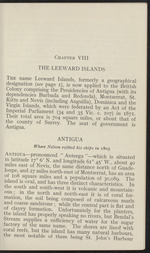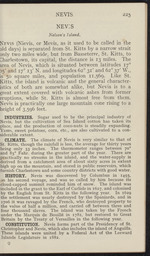| 1 |
 |
“...islands. Next to it in size is Haiti, the old
Espagnola or Hispaniola, comprising Haiti at the
western end and Santo Domingo, both republics.
The British islands are divided into six groups:
(i) The Bahamas; (2) Barbados; (3) Jamaica, with
Turks and Caicos Islands, and the Cayman Islands;
(4) Trinidad and Tobago; (5) the Windward Islands,
including Grenada, St. Lucia, St. Vincent, and the
Grenadines; and (6) the Leeward Islands, comprising
Antigua, with Barbuda and Redonda ; St. Kitts, Nevis,
and Anguilla; Montserrat, Dominica, and the Virgin
The other islands of importance are : Porto Rico and
St Thomas, Santa Cruz or St. Croix, and St. John,
which with some of the neighbouring islets and cays
form the Virgin Islands of the United States (American);
Guadeloupe (with its dependencies the Saintes, Mane
Galante, Desirade or Deseada, and St. Bartholomew),
and Martinique (French) ; Curasao and its dependencies
(Dutch), and St. Martin (owned jointly by the Dutch
and French). • . ,, „ .
British Guiana...”
|
|
| 2 |
 |
“...Chapter VIII
THE LEEWARD ISLANDS
The name Leeward Islands, formerly a geographical
designation (see page i), is now applied to the British
Colony comprising the Presidencies of Antigua (with its
dependencies Barbuda and Redonda), Montserrat, St
Kitts and Nevis (including Anguilla), Dominica and the
Virgin Islands, which were federated by an Act of the
ImperialParliament (34 and 35 Vic. c. 107) in 1871.
Their total area is 704 square miles, or about that of
Anti county of Surrey. The seat of government is
ANTIGUA
Where Nelson refitted his ships in 1805
^Urprr^ced " Anteega ’-which is situated
m latitude 17 6 N. and longitude 61° 45' W. about 40
miles east of Nevis, the same distance north of Guade-
loupe and 27 miles north-east of Montserrat, has an area
of 108 square miles and a population of 30,080. The
tand ^ oval and has three distinct characteristics. In
ous so^h-west it is volcanic and mountain-
mation and north-east it is of coral for-
mation, the soil being composed of calcareous...”
|
|
| 3 |
 |
“...possession of the island ; but in the following
year it was ceded to England by the Treaty of Breda, and the
Government was entrusted to Lord Francis Willoughby's
brother, Lord Willoughby of Parham.
The subsequent history of Antigua has been, on the whole
uneventful. A few years after the cession of the island there
were only five hundred black people in it, while a hundred years
later the population included 37,808 slaves, 1,230 free people
of colour, and 2,590 whites. In 1689 the inhabitants of Anguilla
sought refuge in Antigua, which was defended from the in-
cursions of the French and Indians by Sir Timothy Thornhill
and a body of troops. The notorious Mr. Parke became Governor
in 1706. Violent dissensions arose between him and the
populace, but he refused to resign and was at length killed bv
a riotous mob on December 7th, 1710.1 3
CONSTITUTION. By an Act of 1871, one Executive and one
Legislative Council, under one Governor, were constituted for
the six (now five) Presidencies of the Leeward...”
|
|
| 4 |
 |
“...phosphate
of alumina, which were discovered in 1865 and are
being worked by the Redonda Phosphate Company
under licence subject to the payment of bd. (12c.) per ton
royalty. The exports now amount to nearly 7,000 tons
annually. This "lonely rock," as Charles Kingsley
described it in “ At Last,” is rarely if ever visited by
tourists, to whom it has little to recommend it.
ST. CHRISTOPHER
The Mother Colony of the British West Indies
St. Christopher, better known as St. Kitts, which with
Nevis and Anguilla is a Presidency of the Leeward
Islands, lies in latitude 170 18' N. and longitude 62° 48'
W., 45 miles to the west of Antigua.
The island, which is of volcanic origin and therefore
very mountainous, is about 23 miles long, and has a total
area of 68 square miles and a population of 18,770. The
central part consists of a range of rugged moimtains
running south-east and north-west, culminating in
Mount Misery, 3,711 feet high. These mountains, which
are clothed with virgin forest, bush, and grass...”
|
|
| 5 |
 |
“... brought his ships to anchor at the precise spot which
the French had just quitted, a manoeuvre watched by a large
number of onlookers from the slopes of Nevis. The island was,
however, restored to England by the Treaty of’ Versailles in
1783, following Rodney’s victory over de Grasse off Dominica
on April 12th, 1782. St. Kitts has been British ever since,
although it was raided by Villeneuve in 1805, just before the
battle of Trafalgar.
CONSTITUTION. The Government of St. Kitts, Nevis, and
Anguilla is administered by an officer entitled the Administrator.
The Presidency has an Executive Council and a Legislative
Council over which the Governor, or in his absence the Adminis-
trator, presides. The Council meets in annual session at Basse-
terre in St. Kitts....”
|
|
| 6 |
 |
“...following year. In 1629
the settlement was nearly destroyed by the Spaniards, and in
1706 it was ravaged by the French, who destroyed property to
the value of half a million, and carried off between three and
four thousand slaves. The island was taken by the French
under the Marquis de Bouillé in 1782, but restored to Great
Britain by the Treaty of Versailles in the following year.
CONSTITUTION. Nevis forms part of the Presidency of St.
Christopher and Nevis, which also includes the island of Anguilla.
These islands were united by a Federal Act of the Leeward
Islands Legislature in 1882.
Q...”
|
|
| 7 |
 |
“...ANGUILLA—MONTSERRAT 231
being of no object, and refreshments should be taken to
beguile the tedium of the journey !
ANGUILLA
The Snakeless Snake Island
Anguilla, the most northerly of the Leeward Islands
about 60 miles north-west of St. Kitts, has an area of
35 square miles. It has as dependencies the “ Dogs ”
and neighbouring islets, and a population of 4>23°-
Geologically it consists of coral lying on trap rock
and covered at irregular intervals by a mixture of
red or yellow clay with coralline debris.
INDUSTRIES. Cotton, coco-nuts and sisal are cultivated in
the island, the chief industries of which were until recently
the raising of live-stock and the production of salt and garden
stock.
CLIMATE. Anguilla is very healthy, and there is a marked
absence of malaria and other tropical ailments from this island.
HISTORY. The island, which derives its name from its
resemblance to a snake, or possibly from its having been sup-
posed to be infested with snakes, was discovered by Columbus
on...”
|
|
| 8 |
 |
“...sugar, cotton, and ground provisions, whilst a
variety of grape grows there to perfection. Many of
the peasants subsist by fishing.
Saint Martin, of which one part is owned by France
md the other by the Netherlands (see page 336), takes
ts name from Sieur Saint Martin, who took possession of
:he island by virtue of a Commission of Louis XIII.
rhe chief town in the French quarter is Marigot, and
Jie industry is the cultivation of cptton.
Saint Baxthélemy, or St. Bartholomew, lies to the
south of Anguilla, about 108 miles to the north-west of
Guadeloupe. Its eight square miles are very moun-
.ainous, and its soil, in spite of a scarcity óf moisture, is
lot unfertile. Bananas, quassia, and tamarinds are...”
|
|
| 9 |
 |
“...Caracas Bay (3 hours for the expedition), a former
quarantine station with an ancient Spanish fort and a
delightful beach for bathing, repays a visit. So too
does “ Albertina,” an Ostrich Farm, where ostrich
feathers can be purchased.
In Aruba is the establishment of the “ Lago ” com-
pany, where oil is transferred from the shallow draft
vessels able to cross the two bars at the entrance of
Lake Maracaibo into ocean-going tankers.
ST. MARTIN
The jointly-owned Island
St. Martin, which lies between Anguilla and St. Bar-
tholomew, is partly French and partly Dutch. Twenty
square miles of the island belong to France, and form a
dependency of Guadeloupe, and 18 square miles to
Holland, forming with St. Eustatius and Saba a depen-
dency of Curasao. The island rises to a height of 1,236
feet above the sea, and has only a small cultivable area.
INDUSTRIES. Salt is the principal industry of both colonies
but cotton and live-stock are also exported. The chief settle-
“eI)t ln ‘he French portion is Marigot...”
|
|
| 10 |
 |
“...of, 6t
Mbermarle, Lord, 339, 342
Vlbert, Prince (Duke of York),
visits Trinidad (1913), 127
Albert Victor, Prince, 45, 86,
92, 107, 133, X40, 163
Mfred, Prince. See Edin-
burgh, Duke of
Ml America Cables, 37
Mleyne, Hon. Forster M., 96
Mleyne, Sir John Gay, 83, 106
Mmirante Bay, 417
Mnatuk, 385
Ambergris Cay, 389, 392
Amerigo Vespucci, discoverer,
37°
Amity Hall, 292
Anchovy, Jamaica, 256
Ancon, 3, 419, 427, 428
Andros, 59, 60
Anegada, 246, 248
Anglican Church, the, 10
Angostura bitters, 112
Anguilla, 199, 216, 231
Animal Flower Cave, 108
Annandale, Falls of, 162
Anna’s Hope, 322
Anne, Princess, 216
Annotto Bay, 252, 256, 273,
280
Anopheles mosquito, 5
Anstey, Bishop A. H., 91
Antigua, 197-210
Accommodation in, 200
Area, situation and popula-
tion, 197
Books on, 16
Climate, 198
Communications, 200
Constitution, 199
Dependencies of, 198
Freemasonry, 201
History, 198-9
Parishes, 198
Sports^ 200
Antigua and the Antiguans,
203, 207
Antilla or Antiglia, 1
Antilla, Cuba,/ 341, 357
Antilles, Greater...”
|
|
